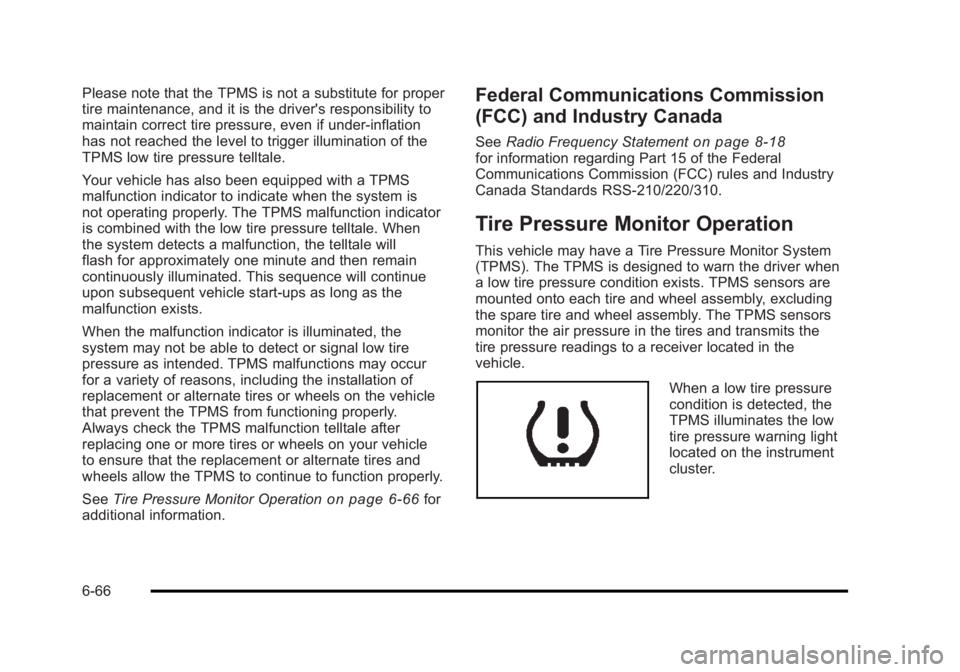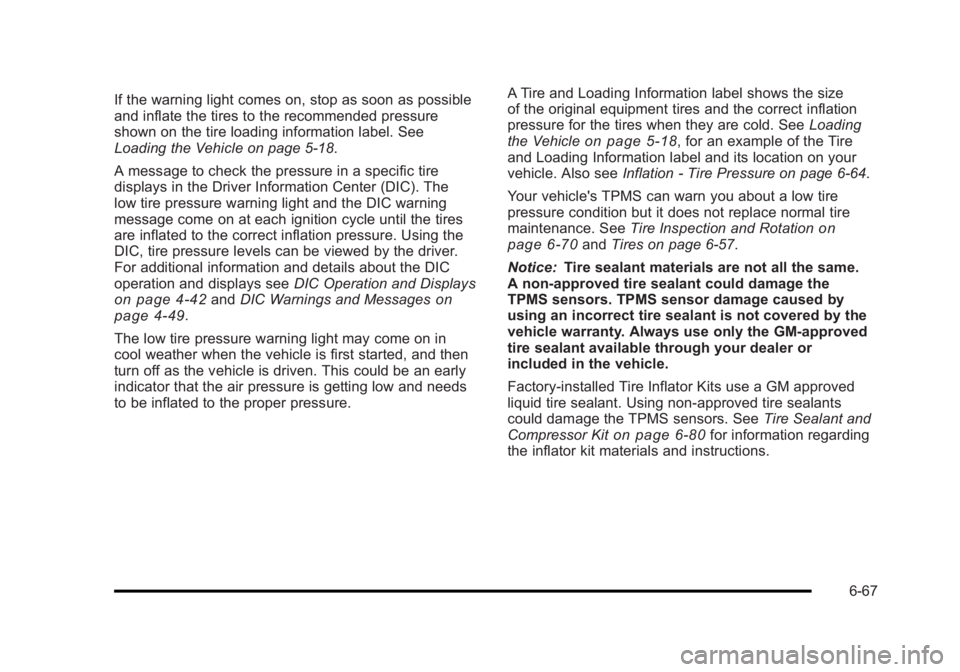sensor BUICK LUCERNE 2011 Owner's Guide
[x] Cancel search | Manufacturer: BUICK, Model Year: 2011, Model line: LUCERNE, Model: BUICK LUCERNE 2011Pages: 450, PDF Size: 3.63 MB
Page 352 of 450

Black plate (66,1)Buick Lucerne Owner Manual - 2011
Please note that the TPMS is not a substitute for proper
tire maintenance, and it is the driver's responsibility to
maintain correct tire pressure, even if under‐inflation
has not reached the level to trigger illumination of the
TPMS low tire pressure telltale.
Your vehicle has also been equipped with a TPMS
malfunction indicator to indicate when the system is
not operating properly. The TPMS malfunction indicator
is combined with the low tire pressure telltale. When
the system detects a malfunction, the telltale will
flash for approximately one minute and then remain
continuously illuminated. This sequence will continue
upon subsequent vehicle start‐ups as long as the
malfunction exists.
When the malfunction indicator is illuminated, the
system may not be able to detect or signal low tire
pressure as intended. TPMS malfunctions may occur
for a variety of reasons, including the installation of
replacement or alternate tires or wheels on the vehicle
that prevent the TPMS from functioning properly.
Always check the TPMS malfunction telltale after
replacing one or more tires or wheels on your vehicle
to ensure that the replacement or alternate tires and
wheels allow the TPMS to continue to function properly.
SeeTire Pressure Monitor Operation
on page 6‑66for
additional information.
Federal Communications Commission
(FCC) and Industry Canada
See Radio Frequency Statementon page 8‑18for information regarding Part 15 of the Federal
Communications Commission (FCC) rules and Industry
Canada Standards RSS-210/220/310.
Tire Pressure Monitor Operation
This vehicle may have a Tire Pressure Monitor System
(TPMS). The TPMS is designed to warn the driver when
a low tire pressure condition exists. TPMS sensors are
mounted onto each tire and wheel assembly, excluding
the spare tire and wheel assembly. The TPMS sensors
monitor the air pressure in the tires and transmits the
tire pressure readings to a receiver located in the
vehicle.
When a low tire pressure
condition is detected, the
TPMS illuminates the low
tire pressure warning light
located on the instrument
cluster.
6-66
Page 353 of 450

Black plate (67,1)Buick Lucerne Owner Manual - 2011
If the warning light comes on, stop as soon as possible
and inflate the tires to the recommended pressure
shown on the tire loading information label. See
Loading the Vehicle on page 5‑18.
A message to check the pressure in a specific tire
displays in the Driver Information Center (DIC). The
low tire pressure warning light and the DIC warning
message come on at each ignition cycle until the tires
are inflated to the correct inflation pressure. Using the
DIC, tire pressure levels can be viewed by the driver.
For additional information and details about the DIC
operation and displays seeDIC Operation and Displays
on page 4‑42andDIC Warnings and Messageson
page 4‑49.
The low tire pressure warning light may come on in
cool weather when the vehicle is first started, and then
turn off as the vehicle is driven. This could be an early
indicator that the air pressure is getting low and needs
to be inflated to the proper pressure. A Tire and Loading Information label shows the size
of the original equipment tires and the correct inflation
pressure for the tires when they are cold. See
Loading
the Vehicle
on page 5‑18, for an example of the Tire
and Loading Information label and its location on your
vehicle. Also see Inflation - Tire Pressure on page 6‑64.
Your vehicle's TPMS can warn you about a low tire
pressure condition but it does not replace normal tire
maintenance. See Tire Inspection and Rotation
on
page 6‑70and Tires on page 6‑57.
Notice: Tire sealant materials are not all the same.
A non-approved tire sealant could damage the
TPMS sensors. TPMS sensor damage caused by
using an incorrect tire sealant is not covered by the
vehicle warranty. Always use only the GM-approved
tire sealant available through your dealer or
included in the vehicle.
Factory-installed Tire Inflator Kits use a GM approved
liquid tire sealant. Using non-approved tire sealants
could damage the TPMS sensors. See Tire Sealant and
Compressor Kit
on page 6‑80for information regarding
the inflator kit materials and instructions.
6-67
Page 354 of 450

Black plate (68,1)Buick Lucerne Owner Manual - 2011
TPMS Malfunction Light and Message
The TPMS will not function properly if one or more of
the TPMS sensors are missing or inoperable. When
the system detects a malfunction, the low tire pressure
warning light flashes for about one minute and then
stays on for the remainder of the ignition cycle. A DIC
warning message also displays. The malfunction light
and DIC warning message come on at each ignition
cycle until the problem is corrected. Some of the
conditions that can cause these to come on are:
.One of the road tires has been replaced with the
spare tire. The spare tire does not have a TPMS
sensor. The malfunction light and the DIC message
should go off after the road tire is replaced and
the sensor matching process is performed
successfully. See "TPMS Sensor Matching
Process" later in this section.
.The TPMS sensor matching process was not done
or not completed successfully after rotating the
tires. The malfunction light and the DIC message
should go off after successfully completing the
sensor matching process. See "TPMS Sensor
Matching Process" later in this section.
.One or more TPMS sensors are missing or
damaged. The malfunction light and the DIC
message should go off when the TPMS sensors
are installed and the sensor matching process is
performed successfully. See your dealer for
service.
.Replacement tires or wheels do not match the
original equipment tires or wheels. Tires and
wheels other than those recommended could
prevent the TPMS from functioning properly. See
Buying New Tires on page 6‑72.
.Operating electronic devices or being near facilities
using radio wave frequencies similar to the TPMS
could cause the TPMS sensors to malfunction.
If the TPMS is not functioning properly, it cannot detect
or signal a low tire condition. See your dealer for
service if the TPMS malfunction light and DIC message
comes on and stays on.
6-68
Page 355 of 450

Black plate (69,1)Buick Lucerne Owner Manual - 2011
TPMS Sensor Matching Process
Each TPMS sensor has a unique identification code.
The identification code needs to be matched to a new
tire/wheel position after rotating the vehicle’s tires or
replacing one or more of the TPMS sensors. Also, the
TPMS sensor matching process should be performed
after replacing a spare tire with a road tire containing
the TPMS sensor. The malfunction light and the DIC
message should go off at the next ignition cycle. The
sensors are matched to the tire/wheel positions, using a
TPMS relearn tool, in the following order: driver side
front tire, passenger side front tire, passenger side rear
tire, and driver side rear. See your dealer for service or
to purchase a relearn tool.
There are two minutes to match the first tire/wheel
position, and five minutes overall to match all four tire/
wheel positions. If it takes longer, the matching process
stops and must be restarted.
The TPMS sensor matching process is:1. Set the parking brake.
2. Turn the ignition to ON/RUN with the engine off.
3. Press the Remote Keyless Entry (RKE) transmitter's lock and unlock buttons at the same
time for approximately five seconds. The horn
sounds twice to signal the receiver is in relearn
mode and TIRE LEARNING ACTIVE message
displays on the DIC screen. 4. Start with the driver side front tire.
5. Place the relearn tool against the tire sidewall,
near the valve stem. Then press the button to
activate the TPMS sensor. A horn chirp confirms
that the sensor identification code has been
matched to this tire and wheel position.
6. Proceed to the passenger side front tire, and repeat the procedure in Step 5.
7. Proceed to the passenger side rear tire, and repeat the procedure in Step 5.
8. Proceed to the driver side rear tire, and repeat the procedure in Step 5. The horn sounds two times to
indicate the sensor identification code has been
matched to the driver side rear tire, and the TPMS
sensor matching process is no longer active. The
TIRE LEARNING ACTIVE message on the DIC
display screen goes off.
9. Turn the ignition to LOCK/OFF.
10. Set all four tires to the recommended air pressure level as indicated on the Tire and Loading
Information label.
6-69
Page 363 of 450

Black plate (77,1)Buick Lucerne Owner Manual - 2011
Your dealer will know the kind of wheel you need.
Each new wheel should have the same load-carrying
capacity, diameter, width, offset, and be mounted the
same way as the one it replaces.
If you need to replace any of your wheels, wheel bolts,
wheel nuts, or Tire Pressure Monitor System (TPMS)
sensors, replace them only with new GM original
equipment parts. This way, you will be sure to have the
right wheel, wheel bolts, wheel nuts, and TPMS sensors
for your vehicle.
{WARNING:
Using the wrong replacement wheels, wheel bolts,
or wheel nuts can be dangerous. It could affect
the braking and handling of the vehicle. Tires can
lose air, and cause loss of control, causing a
crash. Always use the correct wheel, wheel bolts,
and wheel nuts for replacement.Notice:
The wrong wheel can also cause problems
with bearing life, brake cooling, speedometer or
odometer calibration, headlamp aim, bumper height,
vehicle ground clearance, and tire or tire chain
clearance to the body and chassis.
See Changing a Flat Tire
on page 6‑88for more
information.
Used Replacement Wheels
{WARNING:
Replacing a wheel with a used one is dangerous.
How it has been used or how far it has been
driven may be unknown. It could fail suddenly and
cause a crash. When replacing wheels, use a new
GM original equipment wheel.
6-77
Page 395 of 450

Black plate (109,1)Buick Lucerne Owner Manual - 2011
Fuses Usage
1 Engine Control Module (ECM), Crank
2 Fuel Injectors Odd
3 Fuel Injectors Even
4 Air Conditioning Clutch
Fuses Usage
5 Air Injection Reactor (AIR) Solenoid
6 Oxygen Sensor
7 Emission Device
8 Transmission, Ignition 1
6-109